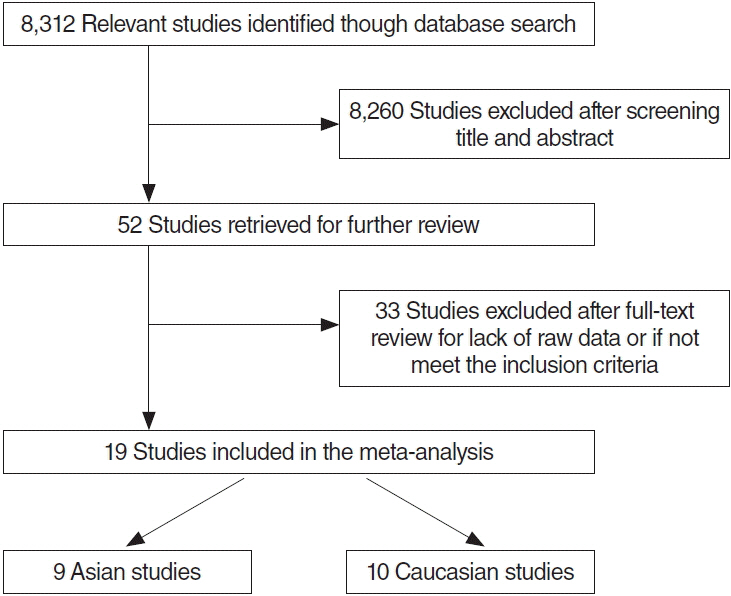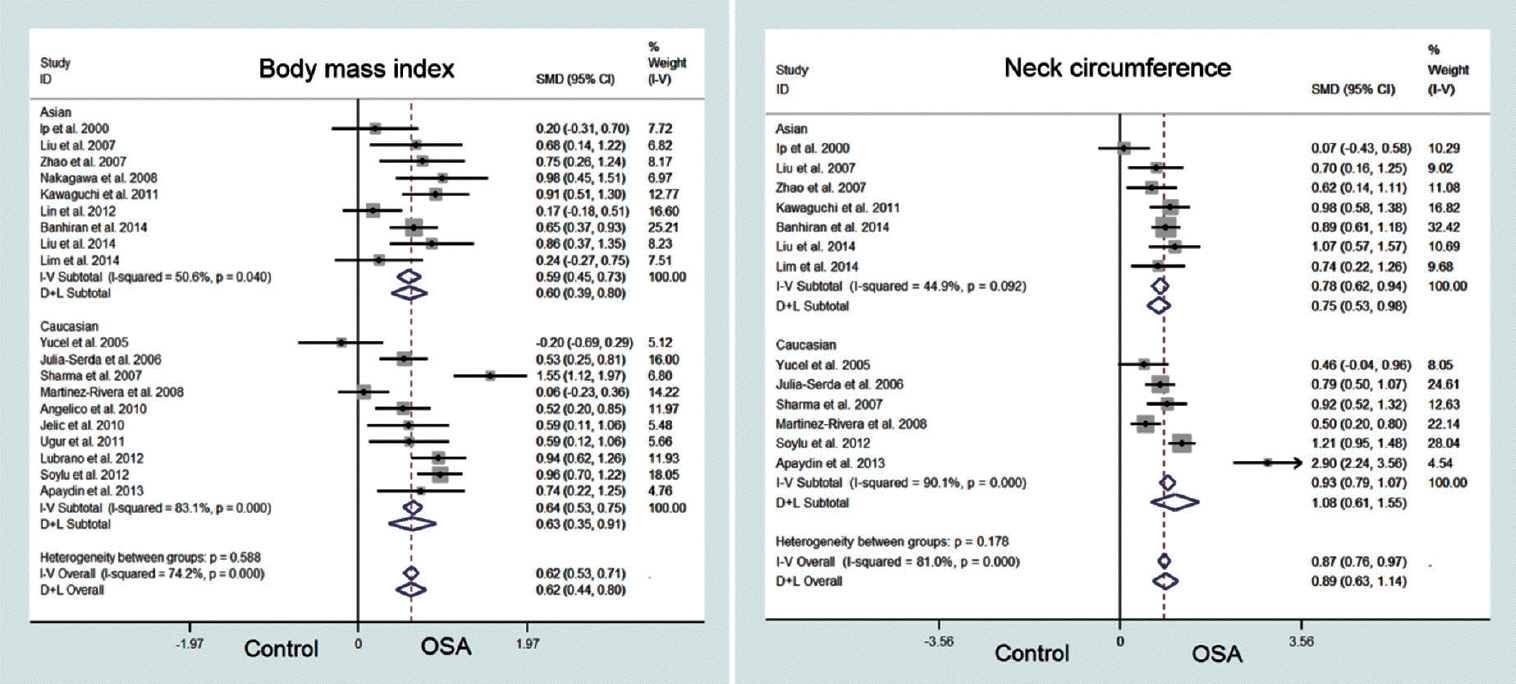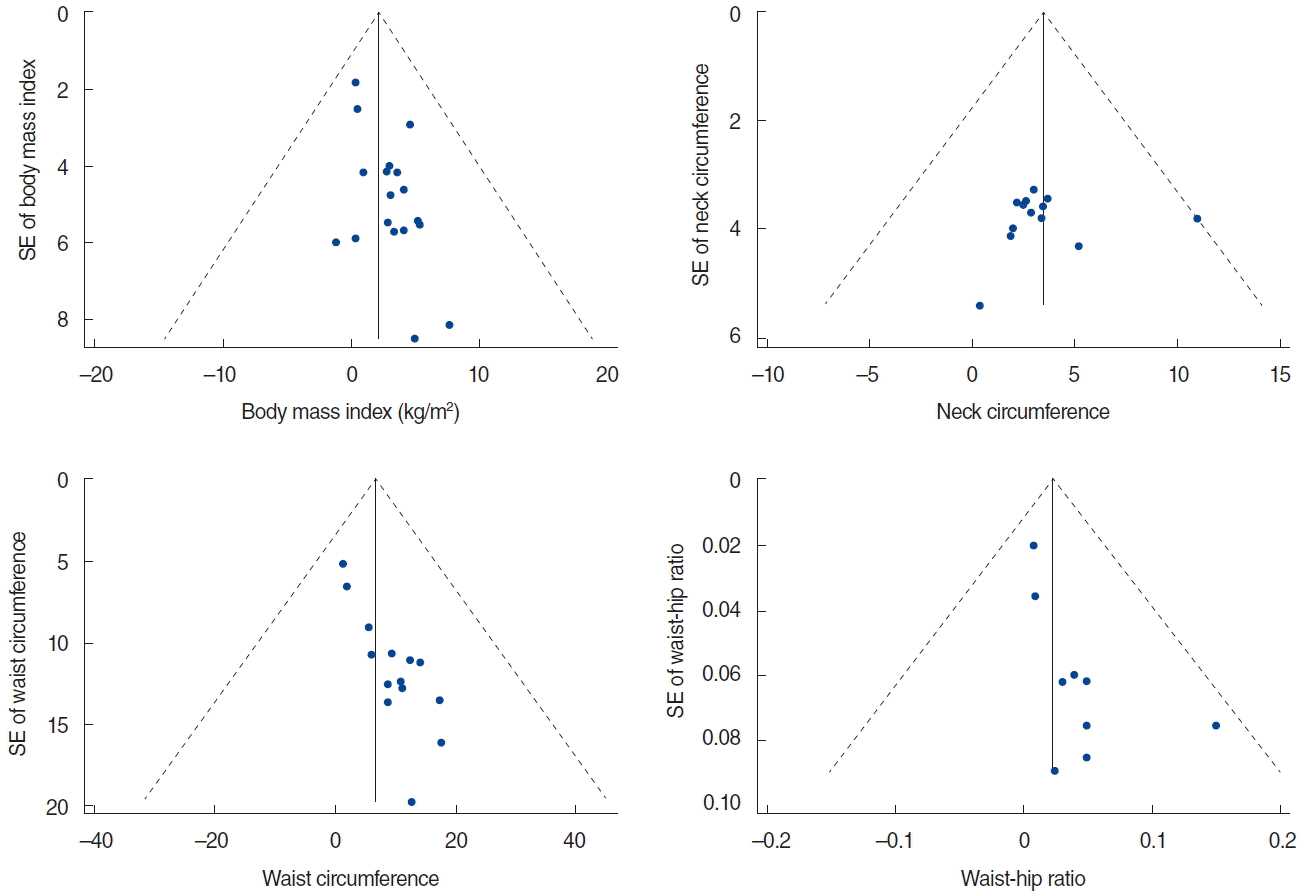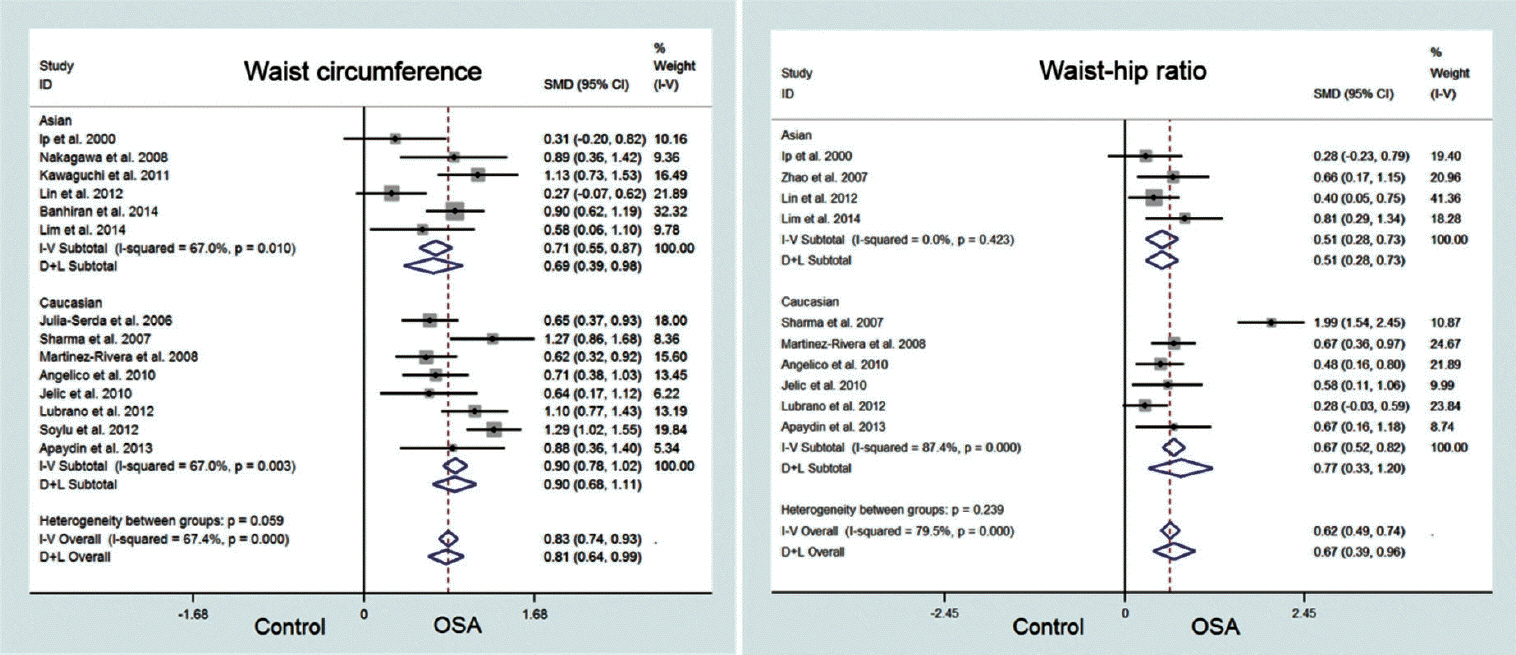Clin Exp Otorhinolaryngol.
2016 Mar;9(1):1-7. 10.21053/ceo.2016.9.1.1.
Comparison of Anthropometric Data Between Asian and Caucasian Patients With Obstructive Sleep Apnea: A Meta-Analysis
- Affiliations
-
- 1Department of Otorhinolaryngology-Head and Neck Surgery, Konkuk University College of Medicine, Seoul, Korea.
- 2Department of Otorhinolaryngology-Head and Neck Surgery, Soonchunhyang University Bucheon Hospital, Soonchunhyang University College of Medicine, Bucheon, Korea.
- 3Department of Head and Neck Surgery, UCLA School of Medicine, Los Angeles, CA, USA.
- 4Department of Occupational and Environmental Medicine, Kangbuk Samsung Hospital, Sungkyunkwan University School of Medicine, Seoul, Korea. sh703.yoo@gmail.com
- 5Department of Otorhinolaryngology-Head and Neck Surgery, Hanyang University College of Medicine, Seoul, Korea. shcho@hanyang.ac.kr
- KMID: 2166272
- DOI: http://doi.org/10.21053/ceo.2016.9.1.1
Abstract
OBJECTIVES
Obesity is considered to be one of the most important risk factors for obstructive sleep apnea (OSA) but less is known about the role of ethnicity in OSA. The purpose of this study was to investigate the interethnic difference of obesity-related phenotypes in OSA and to reveal the role of ethnicity in OSA.
METHODS
We searched MEDLINE, LILACS, Scopus, and the Cochrane Library using the key words "sleep apnea," "body mass index," "neck circumference," "waist circumference," "waist to hip ratio," etc. Inclusion criteria were adults over 18 years of age, and studies that included polysomnography, obesity-related parameters, and a clear demarcation of ethnicity in the patient population. Included studies were reviewed by 2 independent reviewers. The following information was collected for controls and OSA: number, age, gender, country, ethnicity (Asian or Caucasian), study design, apnea-hypopnea index/respiratory disturbance index, body mass index (BMI), neck circumference (NC), waist circumference (WC), and/or waist to hip ratio (WHR).
RESULTS
A total of 8,312 publications were retrieved with a subsequent 19 manuscripts that met the selection criteria. A total of 2,966 patients were included for analysis. The main findings were as follows: There was no difference in BMI, WC, and WHR between patients with OSA and controls after accounting for publication bias; Patients with OSA have greater NC than controls (standard mean difference, 0.89; 95% confidence interval, 0.63 to 1.14); and There was no difference in NC between Asian and Caucasians patients (P=0.178).
CONCLUSION
OSA might not be related with BMI, WC, and WHR. Only NC demonstrated a strong association with OSA, and this finding was not different between Asians and Caucasians.
MeSH Terms
Figure
Cited by 1 articles
-
Anthropometric Characteristics of Korean Patients with Obstructive Sleep Apnea
Jae Hoon Cho, Ji Ho Choi, Bora Lee, Sue-Jean Mun, Woo Yong Bae, Sung Wan Kim, Seok Hyun Cho
J Rhinol. 2018;25(2):80-85. doi: 10.18787/jr.2018.25.2.80.
Reference
-
1. Young T, Palta M, Dempsey J, Skatrud J, Weber S, Badr S. The occurrence of sleep-disordered breathing among middle-aged adults. N Engl J Med. 1993; Apr. 328(17):1230–5.
Article2. Vgontzas AN. Does obesity play a major role in the pathogenesis of sleep apnoea and its associated manifestations via inflammation, visceral adiposity, and insulin resistance? Arch Physiol Biochem. 2008; Oct. 114(4):211–23.
Article3. Namyslowski G, Scierski W, Mrowka-Kata K, Kawecka I, Kawecki D, Czecior E. Sleep study in patients with overweight and obesity. J Physiol Pharmacol. 2005; Dec. 56 Suppl 6:59–65.4. Ip MS, Lam KS, Ho C, Tsang KW, Lam W. Serum leptin and vascular risk factors in obstructive sleep apnea. Chest. 2000; Sep. 118(3):580–6.
Article5. Yucel A, Unlu M, Haktanir A, Acar M, Fidan F. Evaluation of the upper airway cross-sectional area changes in different degrees of severity of obstructive sleep apnea syndrome: cephalometric and dynamic CT study. AJNR Am J Neuroradiol. 2005; Nov-Dec. 26(10):2624–9.6. Julia-Serda G, Perez-Penate G, Saavedra-Santana P, Ponce-Gonzalez M, Valencia-Gallardo JM, Rodriguez-Delgado R, et al. Usefulness of cephalometry in sparing polysomnography of patients with suspected obstructive sleep apnea. Sleep Breath. 2006; Dec. 10(4):181–7.
Article7. Zhao ZH, Sullivan C, Liu ZH, Luo Q, Xiong CM, Ni XH, et al. Prevalence and clinical characteristics of sleep apnea in Chinese patients with heart failure. Int J Cardiol. 2007; May. 118(1):122–3.
Article8. Sharma SK, Kumpawat S, Goel A, Banga A, Ramakrishnan L, Chaturvedi P. Obesity, and not obstructive sleep apnea, is responsible for metabolic abnormalities in a cohort with sleep-disordered breathing. Sleep Med. 2007; Jan. 8(1):12–7.9. Liu KH, Chu WC, To KW, Ko FW, Tong MW, Chan JW, et al. Sonographic measurement of lateral parapharyngeal wall thickness in patients with obstructive sleep apnea. Sleep. 2007; Nov. 30(11):1503–8.
Article10. Martinez-Rivera C, Abad J, Fiz JA, Rios J, Morera J. Usefulness of truncal obesity indices as predictive factors for obstructive sleep apnea syndrome. Obesity (Silver Spring). 2008; Jan. 16(1):113–8.
Article11. Nakagawa Y, Kishida K, Kihara S, Sonoda M, Hirata A, Yasui A, et al. Nocturnal reduction in circulating adiponectin concentrations related to hypoxic stress in severe obstructive sleep apnea-hypopnea syndrome. Am J Physiol Endocrinol Metab. 2008; Apr. 294(4):E778–84.
Article12. Jelic S, Lederer DJ, Adams T, Padeletti M, Colombo PC, Factor PH, et al. Vascular inflammation in obesity and sleep apnea. Circulation. 2010; Mar. 121(8):1014–21.
Article13. Angelico F, del Ben M, Augelletti T, de Vita R, Roma R, Violi F, et al. Obstructive sleep apnoea syndrome and the metabolic syndrome in an internal medicine setting. Eur J Intern Med. 2010; Jun. 21(3):191–5.
Article14. Ugur KS, Ark N, Kurtaran H, Kizilbulut G, Cakir B, Ozol D, et al. Subcutaneous fat tissue thickness of the anterior neck and umbilicus in patients with obstructive sleep apnea. Otolaryngol Head Neck Surg. 2011; Sep. 145(3):505–10.
Article15. Kawaguchi Y, Fukumoto S, Inaba M, Koyama H, Shoji T, Shoji S, et al. Different impacts of neck circumference and visceral obesity on the severity of obstructive sleep apnea syndrome. Obesity (Silver Spring). 2011; Feb. 19(2):276–82.
Article16. Soylu AC, Levent E, Sariman N, Yurtlu S, Alparslan S, Saygı A. Obstructive sleep apnea syndrome and anthropometric obesity indexes. Sleep Breath. 2012; Dec. 16(4):1151–8.
Article17. Lubrano C, Saponara M, Barbaro G, Specchia P, Addessi E, Costantini D, et al. Relationships between body fat distribution, epicardial fat and obstructive sleep apnea in obese patients with and without metabolic syndrome. PLoS One. 2012; 7(10):e47059.
Article18. Lin QC, Zhang XB, Chen GP, Huang DY, Din HB, Tang AZ. Obstructive sleep apnea syndrome is associated with some components of metabolic syndrome in nonobese adults. Sleep Breath. 2012; Jun. 16(2):571–8.
Article19. Apaydin M, Ayik SO, Akhan G, Peker S, Uluc E. Carotid intima-media thickness increase in patients with habitual simple snoring and obstructive sleep apnea syndrome is associated with metabolic syndrome. J Clin Ultrasound. 2013; Jun. 41(5):290–6.
Article20. Liu KH, Chu WC, To KW, Ko FW, Ng SS, Ngai JC, et al. Mesenteric fat thickness is associated with increased risk of obstructive sleep apnoea. Respirology. 2014; Jan. 19(1):92–7.
Article21. Banhiran W, Junlapan A, Assanasen P, Chongkolwatana C. Physical predictors for moderate to severe obstructive sleep apnea in snoring patients. Sleep Breath. 2014; Mar. 18(1):151–8.
Article22. Lim YH, Choi J, Kim KR, Shin J, Hwang KG, Ryu S, et al. Sex-specific characteristics of anthropometry in patients with obstructive sleep apnea: neck circumference and waist-hip ratio. Ann Otol Rhinol Laryngol. 2014; Jul. 123(7):517–23.23. Lam B, Lam DC, Ip MS. Obstructive sleep apnoea in Asia. Int J Tuberc Lung Dis. 2007; Jan. 11(1):2–11.24. Villaneuva AT, Buchanan PR, Yee BJ, Grunstein RR. Ethnicity and obstructive sleep apnoea. Sleep Med Rev. 2005; Dec. 9(6):419–36.
Article25. Cavalli-Sforza LL, Menozzi P, Piazza A. The history and geography of human genes. Princeton (NJ): Princeton University Press;1994.26. Egger M, Davey Smith G, Schneider M, Minder C. Bias in meta-analysis detected by a simple, graphical test. BMJ. 1997; Sep. 315(7109):629–34.
Article27. Duval S, Tweedie R. Trim and fill: a simple funnel-plot-based method of testing and adjusting for publication bias in meta-analysis. Biometrics. 2000; Jun. 56(2):455–63.
Article28. Young T, Peppard PE, Taheri S. Excess weight and sleep-disordered breathing. J Appl Physiol (1985). 2005; Oct. 99(4):1592–9.
Article29. Fogel RB, Malhotra A, White DP. Sleep. 2: pathophysiology of obstructive sleep apnoea/hypopnoea syndrome. Thorax. 2004; Feb. 59(2):159–63.30. Ong KC, Clerk AA. Comparison of the severity of sleep-disordered breathing in Asian and Caucasian patients seen at a sleep disorders center. Respir Med. 1998; Jun. 92(6):843–8.
Article31. Li KK, Kushida C, Powell NB, Riley RW, Guilleminault C. Obstructive sleep apnea syndrome: a comparison between Far-East Asian and white men. Laryngoscope. 2000; Oct. 110(10 Pt 1):1689–93.
Article32. Peters JL, Sutton AJ, Jones DR, Abrams KR, Rushton L. Performance of the trim and fill method in the presence of publication bias and between-study heterogeneity. Stat Med. 2007; Nov. 26(25):4544–62.
Article
- Full Text Links
- Actions
-
Cited
- CITED
-
- Close
- Share
- Similar articles
-
- A Review of a Recent Meta-Analysis Study on Obstructive Sleep Apnea
- Predictors for Presence and Severity of Obstructive Sleep Apnea in Snoring Patients: Significance of Neck Circumference
- Pathogenesis of Obstructive Sleep Apnea
- A Case of Huge Lingual Tonsillar Hypertrophy Causing Obstructive Sleep Apnea in Adult
- Complications of Obstructive Sleep Apnea





